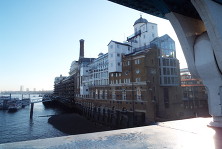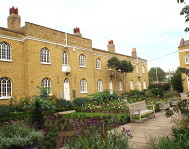








Butler's Wharf
The regeneration of Butler’s Wharf is a huge success story and an exemplar of the rebirth of the former London docks after they fell into disuse in the 1970s. The area comprises 25 acres and the redevelopment included not just the vast river-facing warehouses but buildings in the labyrinth behind. It was a small town in itself, in the past a network of imposing warehouses and small terraced houses away from the river, today a network of these same refurbished warehouses side by side with recently built blocks of apartments and offices.
Sadly, there is no record existing of Mr Butler’s first name but there is a record of a Mr Butler, who traded in grain, renting warehouses in 1794. It seems he had a partner, at least for a short while, for in November of that year, a classified advert appeared in The Times that invited interested customers to view goods at Holland and Butler’s Wharf, Horslydown. The goods formed part of the cargo aboard the ship the Countess de Galvert that had been stranded on its journey back from Jamaica and included rum, loose cotton, ginger, Nicaraguan wood, mahogany and fustic.
The large range of warehouse buildings fronting onto the river were built between 1871 and 1873 and included the much photographed high level iron foot-bridges over Shad Thames that linked the warehouses on the river front with those behind. The wharf dealt in many commodities including grain, sugar, cloves, cinnamon, rubber, tea and tapioca. It rose to become one of the most important wharfingers in the area, second only to Hay’s Wharf.
The Design Museum moved to a new home at Shad Thames as part of the renovation and for a while their neighbour was the Bramah Tea and Coffee Museum. Other architects and developers converted further derelict warehouses nearby to the south and new blocks were erected. The Courage Brewery, which had ceased brewing in 1982 and is located next door to Butler’s Wharf, was also renovated.
Today, other than the sweep of the river and the literal bricks and mortar, the area bears no resemblance to how it was fifty years ago, transformed into a thriving neighbourhood of restaurants, bars, shops, galleries, flats and offices, a desirable place to live and a go-to tourist destination.
A hundred years after they were built, the warehouses fell silent when the Port of London closed in 1972 and artists including David Hockney, Andrew Logan and Derek Jarman moved into the empty buildings. In 1981, Sir Terence Conran led a successful bid for a mixed use redevelopment. Butler’s Wharf near neighbour New Concordia Wharf at St Saviour’s Dock was already well into the process of a mixed use renovation. The renovation of Butler's Wharf was a 20 year project that involved renovating and developing six buildings: the Butlers Wharf building itself, and the renamed Cardamom, Clove, Cinnamon, Nutmeg and Coriander warehouses.
'Exotic Cargo' by Peter Randall-Page on the corner of Butler's Wharf and St Saviour's Dock, Thames Path.
'Head of Invention' by Eduardo Paulozzi outside the Design Museum, Thames Path.